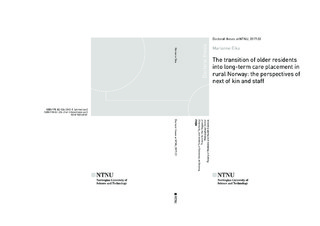| dc.description.abstract | Purpose: The overall purpose of this project was to explore the transition into long-term care placement for older residents from different perspectives in order to maintain and enhance health and well-being, and inform practice and improve care.
Methods: An ethnographic design used three sources of data, periodic participating observations, individual semi-structured interviews, and reading of relevant documents. The project comprises three studies. The aim of study I was to describe and explore the experiences of next of kin during the older residents’ transition into long term care placement. I interviewed ten next of kin to eight newly admitted residents. The next of kin talked about their experiences during the preparation period, the arrival day, and the first week after placement. The aim of study II was to explore and describe the staff’s actions during the initial transition process for the older residents into long-term care facility. In study III, the aims were to explore and describe the staff’s interactions during the older residents’ transition into long-term care facility, and explore how the staff interactions may influence their assistance and care of the older residents. In studies II and III, I followed through periodic participating observations, the staff who assisted ten new residents during the preparation period, arrival day, and the first week after placement. Moreover, I interviewed sixteen staff and the leader of the institutional services, and read relevant documents. Thematic analyses were used to analyze the data in studies I and III and content analysis inspired the analysis of study II.
Main findings: What happened prior to the long-term care placement as well as what happened in the initial period in the nursing home influenced the experiences of the next of kin and relationships within the family (I). Moreover, it influenced staff’s actions and interactions, which ultimately influenced the older residents’ transition processes (II, III). The next of kin strove to handle the new situation. They kept on feeling responsible for their older family member, and provided continuity with their past life. Structural arrangements, such as the older family member having to share a private room with a co-resident and being moved about in the nursing home frustrated the next of kin. They did not expect much for themselves, apart from staff notice them and approach them during visits. This seldom happened, and they experienced little support from the staff (I). The next of kin and the staff were distant to each other and members from both groups expected the other to approach them. They appeared shy towards each other in this rural community where they knew of each other. In study II, staff’s actions varied from involvement with the new resident to ignorance. Some powerful influential forces on their actions were the management of the facility, individual staff’s formal position, traits, and enthusiasm, resident and staff mix, and local transparency. Both licensed and unlicensed staff were susceptible of performing poor assistance towards the new residents, which may contribute to directing the new resident towards vulnerability and risk. In study III, the staff interactions influenced the new residents’ transition process in complex ways. This study captures some descriptions and connections between micro and macro levels, and some power mechanism at play among the participants that may contribute to enhancing or inhibiting a smooth transition for the older residents and their next of kin. Organizational structures, staff’s formal position, and informal staff alliances were complex and paradoxical. Some powerful influential forces on the staff’s interactions were the previous health care setting, the management of the facility, the strong oral culture, individual staff’s formal position, personality and authority, resident and staff mix, the physician’s round, local transparency, and the taken-for-granted. The findings demonstrate the significance of every agent in the organization, and how each one may influence the staff’s work in unpredictable ways. When happening, the spontaneous staff interactions were “pockets of excellence” and contributed to maintaining the evolving needs of the new residents in the initial period. These interactions depended on dedicated permanent staff who involved everybody present for the best of the new residents, and on the mix of staff at any given time. During holidays with many supply staff, the involved permanent staff were unable to perform their work according to their own standards. Especially the part-time unlicensed supply staff seemed prone at disturbing the work of most permanent staff.
Conclusion: Main areas of concern regarding both the next of kin and the staff were that they needed support and information, and clarify roles between them. Moreover, to maintain the health and well-being of the older residents and their next of kin during the transition involve focus on the playing out of power in staff actions and interactions. In this respect, this project shows some connections and dialectics between macro- and micro levels, which may influence on this: inter organizational level, organizational level, inter professional level, professional level and personal level, as well as contexts and circumstances at any given time. The findings show the importance of involving everybody to the best for the new resident and their next of kin. Combining complexity science with transition theory in nursing provide valuable insights for grass root-, management-, education-, research-, and policy levels how to improve the assistance of the older residents and their next of kin during transitions into longterm care placement. | nb_NO |
| dc.relation.haspart | Paper 3:
Eika, Marianne; Dale, Bjørg; Espnes, Geir Arild; Hvalvik, Sigrun.
Nursing staff interactions during the older residents' transition into long-term care facility in a nursing home in rural Norway: an ethnographic study. BMC Health Services Research 2015 ;Volum 15.(125) s.
https://doi.org/10.1186/s12913-015-0818-z
This article is published under license to BioMed Central Ltd. This is an Open Access article distributed under the terms of the Creative Commons Attribution License which permits unrestricted use, distribution, and reproduction in any medium, provided the original work is properly credited. The Creative Commons Public Domain Dedication waiver (http://creativecommons.org/publicdomain/zero/1.0/) applies to the data made available in this article, unless otherwise stated. | |
